 W
WThis list of hot drinks comprises drinks that are typically served hot. Drinks are liquids specifically prepared for human consumption.
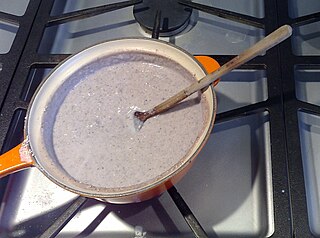 W
WAtole, also known as atolli and atol de elote, is a traditional hot corn- and masa-based beverage of Mesoamerican origin. Chocolate atole is known as champurrado or atole. It typically accompanies tamales, and is very popular during Day of the Dead and Las Posadas.
 W
WBajigur is a hot and sweet beverage native to the Sundanese people of West Java, Indonesia. The main ingredients are coconut milk and Aren sugar; usually to add taste, a small amount of ginger and a small pinch of salt. Traditionally fragrant pandan leaves were added, but now often artificial vanilla powder is used. It can also include kopi tubruk, finely pounded coffee.
 W
WBandrek is a traditional hot, sweet and spicy beverage native to Sundanese of West Java, Indonesia. The Sundanese people who live in the cool, highlands consume bandrek to warm themselves at night and during cold weather.
 W
WBicerin is a traditional hot drink native to Turin, Italy, made of espresso, drinking chocolate, and milk served layered in a small glass.
 W
WCafé de olla is a traditional Mexican coffee beverage. To prepare café de olla, it is essential to use a traditional earthen clay pot, as this gives a special flavor to the coffee. This type of coffee is principally consumed in cold climates and in rural areas.
 W
WA caffè mocha, also called mocaccino, is a chocolate-flavoured variant of a caffè latte, commonly served in a glass. Other commonly used spellings are mochaccino and also mochachino. The name is derived from the city of Mocha, Yemen, which was one of the centers of early coffee trade.
 W
WA caudle was a hot drink that recurred in various guises throughout British cuisine from the Middle Ages into Victorian times. It was thick and sweet, and seen as particularly suitable and sustaining for invalids and new mothers. At some periods of history, caudle recipes were based on milk and eggs, like eggnog. Later variants were more similar to a gruel, a sort of drinkable oatmeal porridge. Like the original forms of posset, a caudle was usually alcoholic.
 W
WChampurrado is a chocolate-based atole, a warm and thick Mexican beverage, prepared with either masa de maíz , masa harina, or corn flour ; piloncillo; water or milk; and occasionally containing cinnamon, anise seed, or vanilla. Ground nuts, orange zest, and egg can also be employed to thicken and enrich the drink. Atole drinks are whipped up using a wooden whisk called a molinillo. The whisk is rolled between the palms of the hands, then moved back and forth in the mixture until it is aerated and frothy; a blender may also be used.
 W
WCoffee is a brewed drink prepared from roasted coffee beans, the seeds of berries from certain Coffea species. When coffee berries turn from green to bright red in color – indicating ripeness – they are picked, processed, and dried. Dried coffee seeds are roasted to varying degrees, depending on the desired flavor. Roasted beans are ground and then brewed with near-boiling water to produce the beverage known as coffee.
 W
WDried lime tea, also known as chai noomi basra, noomi basra tea or loomi tea, is a type of herbal tea made from dried limes that is traditional to the Arab states of the Persian Gulf and Iraq.
 W
WEggnog, historically also known as a milk punch or an egg milk punch when alcoholic beverages are added, is a rich, chilled, sweetened, dairy-based beverage. It is traditionally made with milk, cream, sugar, whipped egg whites, and egg yolks. In some contexts, distilled spirits such as brandy, rum, whisky or bourbon are added to the drink.
 W
WEspresso is a coffee-brewing method of Italian origin, in which a small amount of nearly boiling water is forced under 9–10 bars of pressure (expressed) through finely-ground coffee beans. Espresso coffee can be made with a wide variety of coffee beans and roast degrees. Espresso is the most common way of making coffee in southern Europe, especially in Italy, Spain, Portugal, Switzerland, Southern France and Bulgaria.
 W
WGinger tea is a herbal beverage that is made from ginger root. It has a long history as a traditional herbal medicine in East Asia, South Asia, Southeast Asia and West Asia.
 W
WGlögg or glogg is a spiced, usually alcoholic, mulled wine or spirit. It is a traditional Nordic drink during winter, especially around Christmas.
 W
WHot buttered rum is a mixed drink containing rum, butter, hot water or cider, a sweetener, and various spices. It is especially popular in the fall and winter and is traditionally associated with the holiday season. In the United States, the drink has a venerable history which dates back to colonial days. During that time many families had their own individual recipes, and early Americans believed rum to be nutritious and a strengthener of the body.
 W
WHot chocolate, also known as hot cocoa or drinking chocolate, is a heated drink consisting of shaved chocolate, melted chocolate or cocoa powder, heated milk or water, and usually a sweetener. Hot chocolate may be topped with whipped cream or marshmallows. Hot chocolate made with melted chocolate is sometimes called drinking chocolate, characterized by less sweetness and a thicker consistency.
 W
WKapeng barako, also known as Barako coffee or Batangas coffee, is a coffee varietal grown in the Philippines, particularly in the provinces of Batangas and Cavite. It belongs to the species Coffea liberica. The term is also used to refer to all coffee coming from those provinces. Barako in the languages of the Philippines means "stud", and is associated with the image of masculinity. Barako has a strong flavor and fragrance reminiscent of aniseed.
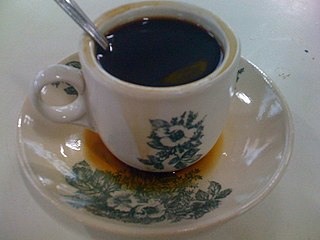 W
WKopi is a type of traditional coffee originating from Singapore. It is a highly caffeinated black coffee served with milk and sugar. This drink has Hainanese roots, being also otherwise known as Nanyang coffee. Nanyang means ‘South Sea’ in Mandarin, and usually references to lands within Maritime Southeast Asia that are located south of the islands of Hainan and Taiwan.
 W
WKurdish coffee, menengic coffee, also pistachio coffee, or terebinth coffee, is a traditional hot beverage in Kurdish and Turkish cuisine. It is made of ground roasted terebinth fruits as the main ingredient, and is caffeine-free. It is particularly popular in parts of southeastern Anatolia.
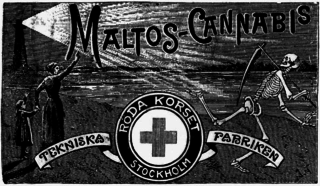 W
WMaltos-Cannabis was a Swedish hemp seed-based malt beverage "food remedy" with sedative qualities produced beginning around the late 19th century into the early 20th century. The product was widely available in Sweden, Denmark, and Norway, and was advertised and reviewed in American publications. An 1899 pharmaceutical reference book printed in Philadelphia defined the product: "A Swedish nutrient in form of a yellowish-white powder, possessing a taste at first saline, later sweetish, and then acrid and bitter."
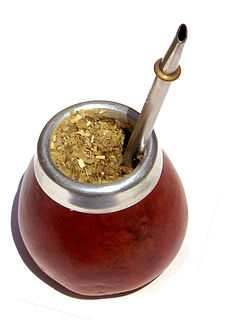 W
WMate or maté also known as chimarrão or cimarrón, is a traditional South American caffeine-rich infused drink. It is made by soaking dried leaves of the holly species Ilex paraguariensis in hot water and is served with a metal straw in a container typically made from a calabash gourd.
 W
WMate cocido, maté tea, kojoi, or yerbiado is an infusion typical of Southern Cone cuisine. It is traditionally prepared by boiling yerba mate in water, then strained and served in cups. It is a bitter tasting beverage, similar to mate but milder, with the same stimulating and nutritional properties. It is also sold in tea-bags, so it can be prepared like tea.
 W
WMilo is a malted chocolate powder typically mixed with milk, with hot water, or both, to produce a beverage.
 W
WA mug is a type of cup typically used for drinking hot drinks, such as coffee, hot chocolate, or tea. Mugs usually have handles and hold a larger amount of fluid than other types of cup. Typically, a mug holds approximately 8–12 US fluid ounces (240–350 ml) of liquid. A mug is a less formal style of drink container and is not usually used in formal place settings, where a teacup or coffee cup is preferred. Shaving mugs are used to assist in wet shaving.
 W
WMulled wine, also known as spiced wine, is a beverage usually made with red wine along with various mulling spices and sometimes raisins. It is served hot or warm and is alcoholic, although there are non-alcoholic versions of it. It is a traditional drink during winter, especially around Christmas. It is served at Christmas markets in Europe.
 W
WOvaltine is a brand of milk flavoring product made with malt extract, sugar, and whey. Some flavors also have cocoa. Ovaltine, a registered trademark of Associated British Foods, is made by Wander AG, a subsidiary of Twinings, which acquired the brand from Novartis in 2002, except in the United States, where Nestlé acquired the rights separately from Novartis in the late 2000s.
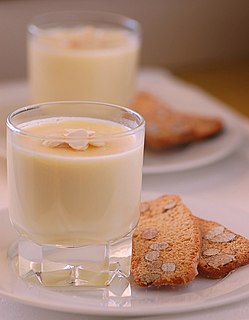 W
WA posset was originally a popular British hot drink made of milk curdled with wine or ale, often spiced, which was often used as a remedy.
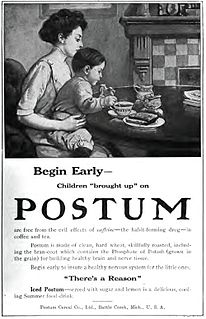 W
WPostum is a powdered roasted-grain beverage popular as a coffee substitute. The caffeine-free beverage was created by Post Cereal Company founder C. W. Post in 1895 and marketed as a healthier alternative to coffee. Post was a student of John Harvey Kellogg, who believed that caffeine was unhealthy. Post Cereal Company eventually became General Foods, which was merged into Kraft Foods. Eliza's Quest Foods now owns the trademark rights and secret recipe of Postum.
 W
WRüdesheimer Kaffee is an alcoholic coffee drink from Rüdesheim am Rhein in Germany invented in 1957 by the German television chef, Hans Karl Adam. It is a popular drink in coffee houses.
 W
WSagada coffee, also known as Sagada arabica, is a single-origin coffee varietal grown in Sagada in the Cordillera highlands of the northern Philippines. It belongs to the species Coffea arabica, of the Typica variety.
 W
WSbiten or sbiten' hot winter Belarusian, Ukrainian, and Russian traditional drink. It has a dark purple appearance and, depending on the recipe, can be very spicy and/or very sweet.
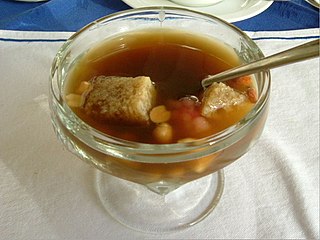 W
WSekoteng, a ginger-based hot drink which includes peanuts, diced bread, and pacar cina, can be found in Jakarta, West Java, and Central Java.
 W
WSmoking Bishop is a type of mulled wine, punch or wassail. It was especially popular in Victorian England at Christmas time and it is mentioned in Dickens' story A Christmas Carol.
 W
WSweet tea is a popular style of iced tea commonly consumed in countries such as the United States, and Indonesia. Sweet tea is most commonly made by adding sugar or simple syrup to black tea either while the tea is brewing or still hot, although artificial sweeteners are also frequently used. Sweet tea is almost always served ice cold. It may sometimes be flavored, most commonly with lemon but also with peach, raspberry, or mint. The drink is sometimes tempered with baking soda to reduce its acidity.
 W
WTeh talua or egg tea is a tea beverage from West Sumatra, Indonesia. The tea is unique because of the use of egg yolk in its preparation. Chicken or duck egg can be chosen for the tea. Other ingredients, in addition to tea and egg yolk, are sugar and calamondin.
 W
WA hot toddy, also known as hot whiskey in Ireland, is typically a mixed drink made of liquor and water with honey, herbs and spices, and served hot. Hot toddy recipes vary and are traditionally drunk before retiring for the night, in wet or cold weather or to relieve the symptoms of the cold and flu. In How to Drink, Victoria Moore describes the drink as "the vitamin C for health, the honey to soothe, the alcohol to numb."
 W
WA Tom and Jerry is a traditional Christmastime cocktail in the United States, devised by British journalist Pierce Egan in the 1820s. It is a variant of eggnog with brandy and rum added and served hot, usually in a mug or a bowl.
 W
WTsokolate, also spelled chocolate, is a native Filipino thick hot chocolate drink. It is made from tabliya or tablea, tablets of pure ground roasted cacao beans, dissolved in water and milk. Like in Spanish and Mexican versions of hot chocolate, the drink is traditionally made in a tsokolatera and briskly mixed with a wooden baton called the molinillo, causing the drink to be characteristically frothy. Tsokolate is typically sweetened with a bit of muscovado sugar, and has a distinctive grainy texture.
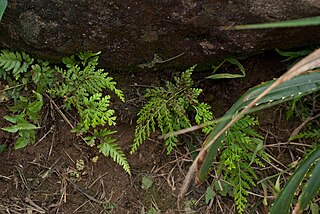 W
WTubho tea, is a traditional herbal tea of the Ivatan people in the Philippines made from dried leaves of the tubho fern.
 W
WWassail is a beverage made from hot mulled cider and spices, drunk traditionally as an integral part of wassailing, an ancient English Yuletide drinking ritual and salutation either involved in door-to-door charity-giving or used to ensure a good cider apple harvest the following year. The drink is now increasingly popular from the Internet as a historical Christmas-time beverage.